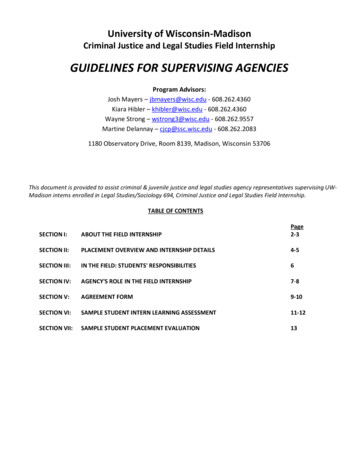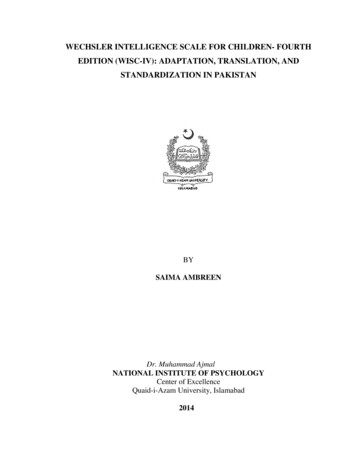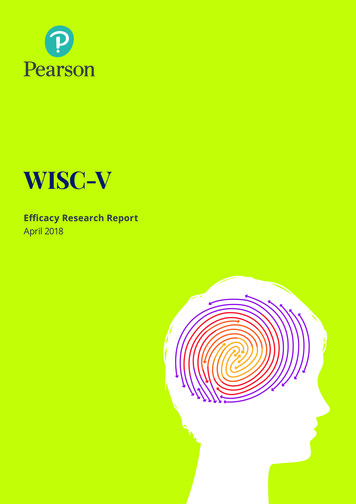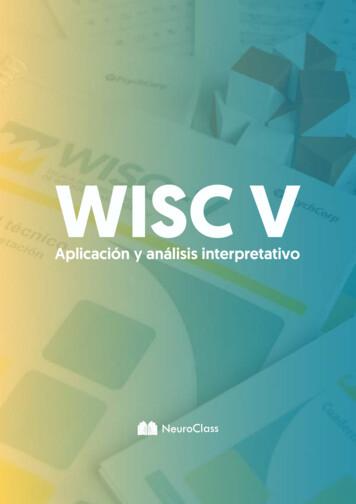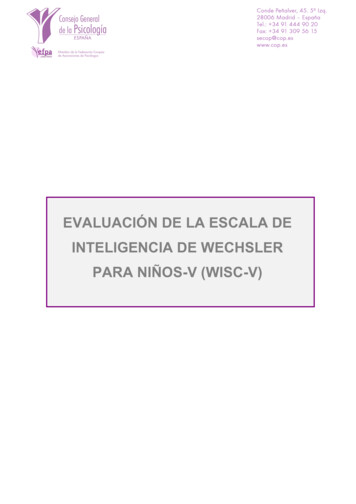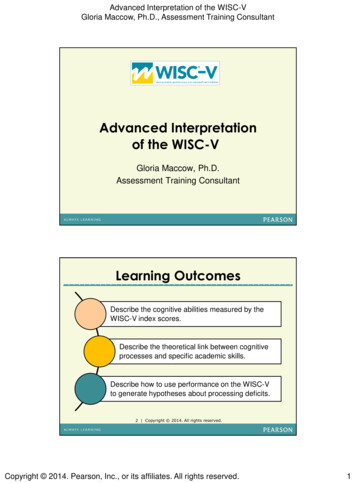
Transcription
Hsin-Yi Chen et al.Higher-order CFA of the Taiwan WISC-IV85Journal of Research in Education Sciences2009, 54(3), 85-108What Does the WISC-IV Measure?Validation of the Scoring and CHC-basedInterpretative ApproachesHsin-Yi ChenTimothy Z. KeithDepartment of Special Education,National Taiwan Normal UniversityProfessorDepartment of Educational Psychology,The University of Texas at Austin, TX, U.S.AProfessorYung-Hwa ChenBen-Sheng ChangThe Chinese Behavioral Science CoporationProfessorDepartment of Psychology,Soochow UniversityAssociate ProfessorAbstractThe validity of WISC-IV current four-factor scoring structure and the Cattell-Horn-Carroll(CHC) theory-based models of the Wechsler Intelligence Scale for Children-Fourth Edition(WISC-IV) were investigated via the application of higher-order confirmatory factor analyses ofscores from the Taiwan WISC-IV standardized sample (n 968). Results reveal that the WISC-IVmeasures the same construct across ages, the resulting interpretation could be applied to childrenwith various age levels. Both the four-factor structure and CHC-based model were supported.Variance explained was similar across models. The general factor accounted for 2/3 of commonvariance. First order factors, in total, contributed an additional 1/3 of common variance. TheWISC-IV measures crystallized ability (Gc), visual processing (Gv), fluid reasoning (Gf), short-termand working memory (Gsm), and processing speed (Gs). In particular, either separating Gf and Gv,or combining them as the Perceptual Reasoning Index (PRI) provides meaningful explanation.Arithmetic showed significant and split loadings. For children in Taiwan, Arithmetic appears areflection of Gsm/Gf and Gc.Keywords: CHC theory, higher order CFA, WISC-IVCorresponding Author: Hsin-Yi Chen, E-mail: hsinyi@ntnu.edu.tw
86Higher-order CFA of the Taiwan WISC-IVHsin-Yi Chen et al.IntroductionAfter 10 years of research on the third edition of the Wechsler Intelligence Scale for Children(WISC-III), one of the primary goals for the recently published fourth edition of this test (WISC-IV)(Wechsler, 2003a, 2007a) was to update its theoretical foundations. New subtests were incorporatedto improve measurement of fluid reasoning, working memory, and processing speed (Wechsler,2003b).Contemporary science in intelligence generally agrees upon a hierarchical model of cognitiveabilities. General intelligence (g) tends to emerge whenever a sufficient number of cognitivelycomplex variables are analyzed (Carroll, 1993). Among empirical cognitive theories, theCattell-Horn-Carroll theory (CHC theory) (Carroll, 1993, 2005) is widely considered as acomprehensive and suitable framework for exploring the nature of cognitive instruments (Flanagan,McGrew, & Ortiz, 2000; Keith, Fine, Taub, Reynolds, & Kranzler, 2006; Keith, Kranzler, &Flanagan, 2001; Keith & Witta, 1997; Kranzler & Keith, 1999; Phelps, McGrew, Knopik, & Ford,2005; Reynolds, Keith, Fine, Fisher, & Low, 2007; Roid, 2003; Woodcock, McGrew, & Mather,2001). Briefly, CHC model locates cognitive abilities into three structural levels. On top of the CHChierarchy is the g. In the middle level are 10 broad abilities, the broad abilities are considered toobroad to be represented by any single measure, thus there are over 70 narrow abilities on the groundlevel. The currently identified broad abilities are crystallized intelligence (Gc), fluid intelligence (Gf),quantitative reasoning (Gq), short-term memory (Gsm), long-term retrieval (Glr), visual processing(Gv), auditory processing (Ga), processing speed (Gs), reading and writing ability (Grw), anddecision/reaction time/speed (Gt). Since this model accommodated both theoretical cognitiveconstructs and empirical findings, no single measurement nowadays covers all CHC abilities, andextension of the construct is still an ongoing action (McGrew, 1997, 2005; McGrew & Flanagan,1998).In a cross-cultural analysis of the WISC-III, data from several countries, including Taiwan,demonstrated firm support for the four-factor scoring structure, namely, Verbal Comprehension(VCI), Perceptual Organization (POI), Freedom from Distractibility (FDI), and Processing Speed(PSI), as proposed by the publisher (Georgas, van de Vijver, Weiss, & Saklofske, 2003). In theWISC-IV, POI is updated by the concept of Perceptual Reasoning (PRI), and FDI is renamed to beWorking Memory (WMI). The WISC-IV four-factor structure has been supported as a fitting model
Hsin-Yi Chen et al.Higher-order CFA of the Taiwan WISC-IV87(Wechsler, 2003b, 2007b). Recently, higher order confirmatory factor analyses on the AmericanWISC-IV norming sample by Keith et al. (2006) suggested that using five CHC broad abilities (Gc,Gv, Gf, Gsm, and Gs) provides a better structure than does the four-factor scoring solution. Inaddition, several WISC-IV subtests, such as Arithmetic, Similarities, Picture Concepts, MatrixReasoning, Block Design, Picture Completion, Coding, and Symbol Search, have been suggested inthe literature as measuring multiple abilities and could show possible cross loadings in factoranalysis. In particular, Arithmetic may provide a mixed measure of fluid and quantitative reasoning,quantitative knowledge, working and short-term memory, verbal comprehension, and speed(Flanagan et al., 2000; Flanagan & Kaufman, 2004; Keith et al., 2006; Phelps et al., 2005). Indeed,one of the WISC-IV revision goals was to increase the working memory load of this subtest(Wechsler, 2003b, p. 8). Table 1 summarizes these hypothesized cross-loadings. All of thesecross-loadings need to be evaluated from a cross-culture perspective.Table 1Hypothesized and Actual Cattell-Horn-Carroll Broad Ability Classifications of theWISC-IV Subtests Based on a Population of Taiwanese ypothesizedActualSimilaritiesGcGcGf lock DesignGvGvGf ?Picture ConceptsGfGfGc ?Matrix ReasoningGfGfGv ?Picture CompletionGvGvGc ?Digit SpanGsmGsmLetter-Number SequencingGsmGsmArithmeticGf / GsmGsm or GfGc ?GcCodingGsGsGsm ?Symbol SearchGsGsGv ?GvCancellationGsGsNote. Gc crystallized intelligence; Gv visual processing; Gf fluid intelligence; Gsm short termmemory; Gs processing speedThe Taiwan version of the WISC-IV was recently developed (Wechsler, 2007a, 2007b). It isworth investigating the psychological structures for the Taiwan children population. A comparison ofcurrent results to the U.S. findings (Keith et al., 2006), would also improve understanding of thecommonalities of cognitive processes across cultures.The purpose of this study was threefold. First, we investigated the constructs underlying the
88Higher-order CFA of the Taiwan WISC-IVHsin-Yi Chen et al.Taiwan WISC-IV by comparing a current four-factor model to a CHC theory-based model. Since ourgoal was to confirm existing models, we decided to take a confirmatory approach for factor analysis,instead of an exploratory manner. Using confirmatory factor analysis for investigating constructvalidity is wildly recognized and applied in the academic field (e.g., Hou, 2009; Wang, 1998).Second, we tested and verified abilities measured by subtests and possible cross-loadings. Finally,we used a Schmid Leiman-type orthogonalization procedure (cf. Schmid & Leiman, 1957; Watkins,2006) to investigate the factor structure via higher-order CFA. We compared across models theinfluence of the higher order general factor and residualized effects of lower order factors.MethodParticipantsWe analyzed the Taiwan WISC-IV standardization responses from 968 children (males n 485;females n 483). This nationally representative sample was divided into 11 age groups from ages 6to 16, with 88 children in each age group. This sample was carefully selected to match the 2007Taiwan Census on region, gender, and parent educational level. The mean age was 11.49, with astandard deviation of 3.18; the average Full-Scaled IQ (FSIQ) was 100 (SD 15). A detaileddescription of this sample is provided in the Taiwan WISC-IV technical manual (Wechsler, 2007b).InstrumentationThe Taiwan version of the WISC-IV (Wechsler, 2007a, 2007b) has 10 core subtests and 4supplemental subtests. The 10 core subtests are: Similarities (SIM), Vocabulary (VOC),Comprehension (COM), Block Design (BLD), Picture Concepts (PCn), Matrix Reasoning (MR),Digit Span (DS), Letter-Number Sequencing (LNS), Coding (CD), and Symbol Search (SYS). Thefour supplemental subtests are Information (INF), Picture Completion (PIC), Arithmetic (ARI), andCancellation (CA). Contents of most test items are identical to those on the American WISC-IV.Revisions were made on most verbal subtests to accommodate cultural differences (Wechsler, 2007b,p. 50). All composites and subtests demonstrated good reliabilities, with average internal reliabilityestimates ranging from .85 to .96 for composites, and .74 to .91 for core subtests.Analysis of the dataTests for the higher order confirmatory factor structure were based on analysis of covariance
Hsin-Yi Chen et al.Higher-order CFA of the Taiwan WISC-IV89structure models using LISREL 8.8 (Jöreskog & Sörbom, 2006). Following the main procedures ofKeith and his colleagues (Keith, 2005; Keith et al., 2006; Keith & Witta, 1997), equivalence ofcovariance matrices across age bands first tested whether the WISC-IV measured the sameconstructs across ages.Both the current four-factor scoring model and the CHC theory-based model with hypothesizedcross loadings were then tested individually. The initial four-factor structure is the one reported inthe WISC-IV manual (Wechsler, 2007a). For the 14-subtest version, this model specifies four verbalcomprehension subtests (Similarities, Vocabulary, Comprehension, Information) on the first factor,four perceptual reasoning subtests (Block Design, Picture Concepts, Matrix Reasoning, PictureCompletion) on the second factor, three working memory subtests (Digit Span, Letter-NumberSequencing, Arithmetic) on the third factor, and three processing speed subtests (Coding, SymbolSearch, Cancellation) on the fourth factor. This model was defined as the initial four-factor model(model A1) in our analyses.We chose Keith’s (Keith et al., 2006, Figure 3) initial CHC model as the starting CHC model(model B1). It specified four subtests (Similarities, Vocabulary, Comprehension, Information) on theGc factor, two subtests (Block Design, Picture Completion) on the Gv factor, three subtests (PictureConcepts, Matrix Reasoning, Arithmetic) on the Gf factor, two subtests (Digit Span, Letter-NumberSequencing) on the Gsm factor, and three processing speed subtests (Coding, Symbol Search,Cancellation) on the Gs factor. In comparison with the WISC-IV four-factor construct, this CHCmodel split the four perceptual reasoning subtests onto separate tests of visual processing and fluidreasoning factors and placed the Arithmetic subtest on the fluid reasoning factor (Flanagan &Kaufman, 2004; Keith et al., 2006).In the testing process, hypothetical split loadings of the following subtests were examined andverified separately: Arithmetic, Similarities, Block Design, Picture Concepts, Matrix Reasoning,Picture Completion, Coding, and Symbol Search. To detect underlying structure and possiblecross-loadings as precisely as possible, we only deleted statistically non-significant factor loadings.We also used a calibration-validation approach. Roughly 70% of the standardization sample (n 668) was randomly selected as the calibration sample for hypotheses testing. The remaining 30%of the cases (n 300) validated the results through cross-validation. Once a best-fitting solutionfrom each of the WISC-IV four-factor models and the CHC-based models was calibrated andvalidated, the final parameter estimates and g-loadings were reported based on the entire sample (n 968). We then applied a Schmid Leiman-type orthogonalization procedure to investigate the sourcesof variance explained and g loadings in each model.
90Higher-order CFA of the Taiwan WISC-IVHsin-Yi Chen et al.For all the higher order confirmatory factor analyses, maximum likelihood was the estimationmethod because of its robustness and sensitivity to incorrectly specified models (Hu & Bentler,1998). Criteria were evaluated jointly to assess overall model fit (Bentler & Bonett, 1980; Marsh,Balla, & McDonald, 1988). These included weighted least squares χ2, the goodness-of-fit index(GFI), the adjusted goodness-of-fit index (AGFI), the normed fit index (NFI), the non-normed fitindex (NNFI), the comparative fit index (CFI), the root mean square error of approximation(RMSEA), the standardized root mean square residual (SRMR), and the Akaike InformationCriterion (AIC). A value of .90 served as the rule-of thumb lower limit of acceptable fit for allindices ranging from zero to 1, with 1 indicating a perfect fit (Hoyle & Panter, 1995; Kline, 2005).An RMSEA of less than .06 and a SRMR of less than .08 corresponded to a “good” fit (Hu &Bentler, 1999; McDonald & Ho, 2002). For comparisons of competing models, the chi squaredifference (Δχ2) tested nested models (Loehlin, 2004). The AIC was used to test non-nested rivalmodels (Kaplan, 2000), with smaller AIC values indicating a better fit.ResultsDoes the Taiwan WISC-IV measure the same construct across ages?In a multi-sample CFA model, we first constrained the variance/covariance matrices to be equalacross four age groups (ages 6-7, 8-10, 11-13, and 14-16). This constrained model fit the data well(RMSEA .046; SRMR .077; NNFI .99). These findings suggested that regardless of age level,children showed fairly invariant WISC-IV subtest correlation patterns. Because any factor structureis derived from these variance/covariance matrices, these find suggest that any factor structure wemay derive should be considered applicable to children of all ages. Subsequent analyses thuscombined data across ages.Does the Taiwan WISC-IV measure the intended four-factor structure?As indicated by all goodness-of-fit indexes reported for the initial four-factor model (model A1)in Table 2, all fit values were within the ideal range. It appears that the scoring model fit Taiwan datawell.Since the Arithmetic subtest is known for measuring multiple abilities, tapping both verbal andmemory domains, we tested a second model in which Arithmetic was allowed to load on both theverbal comprehension and working memory factors (model A2). Model A2 actually fit the data
Hsin-Yi Chen et al.Higher-order CFA of the Taiwan WISC-IV91
92Higher-order CFA of the Taiwan WISC-IVHsin-Yi Chen et al.better than did model A1. The factor loadings of Arithmetic on verbal comprehension and workingmemory factors were .31 and .52 respectively. The χ2 difference between A2 and A1 was significant,suggesting that, after allowing for cross-loadings, A2 had a better fit.Does the Taiwan WISC-IV measure CHC abilities?As indicated by the starting CHC model B1 in Table 2, this CHC model provided a good fit tothe data. Both models A1 and B1 had similar goodness-of-fit, suggesting that both providedreasonable frameworks. We used model B1 as the initial CHC model and proceeded with thefollowing subtest examinations.1. What does the Arithmetic subtest measure?Even though results revealed that model B1 (with Arithmetic loaded only on the Gf factor) hada good fit, to better understand the mixed nature of this subtest, several alternative cross-loadingswere explored.We first tested models in which Arithmetic was allowed to load on only one factor. Although allhad acceptable fit, model B1, with Arithmetic loading on Gf, fit the data better than models allowinga single loading of Arithmetic on Gsm (model B2), Gc (model B3), or a separate first order factor(model B4). Fit values of model B4 were excellent, but the g loading of this factor was 1.38. Thiswas larger than the g loading of Gf ( .92). Given this improbable value, we did not consider loadArithmetic on a separate factor in future models.We tested other models with cross-loadings for Arithmetic. In the literature, Arithmetic is saidto relate to Gf, Gsm, Gc, and Gs factors. When Arithmetic was allowed to cross load on all of thesefour factors (model B5), this model explained the data quite well. The χ2 difference between modelsB5 and B1 was significant, suggesting that the Arithmetic subtest truly is a mixed measure. Theloadings of Arithmetic on the Gf, Gsm, Gc, and Gs factors were .11, .37, .27, and .11, respectively.Interestingly, the Gf factor loading was small and statistically not significant. Cross-validationanalysis showed that loadings of Arithmetic on Gf and Gs were also not significant. Consequently, inmodel B6, Arithmetic was loaded only on Gsm ( .51) and Gc ( .33). The g loadings for Gc, Gv, Gf,Gsm, and Gs were .80, .94, .96, .85, and .65 respectively. All values were considered reasonabletheoretically and were solidly cross-validated.Taken together, these results suggest that when constrained to load on only a single factor,Arithmetic loaded best on the Gf factor. However, when allowed to load on multiple factors,Arithmetic primarily loaded on Gsm, with a salient secondary loading on Gc. Fit values for modelsB1 and B6 were excellent, providing evidence that both were reasonable frameworks. The AIC value
Hsin-Yi Chen et al.Higher-order CFA of the Taiwan WISC-IV93for model B6, however, was slightly lower, suggesting that cross-loading of Arithmetic on Gsm andGc better explained the underlying constructs measured by this test and provided a comparativelybetter approach for interpretation. Therefore, we chose model B6 as the base model for cross-loadingexamination of other selected subtests.2. What do the other subtests measure?(1) Similarities. The Similarities subtest requires children to describe how two objects orconcepts are similar. Compared to other verbal comprehension subtests such as Vocabulary andInformation, this subtest appears to require relatively more inductive reasoning. It thus was areasonable assumption that this subtest should have a minor cross-loading on Gf. As shown in modelC1, allowing this subtest to load on both the Gc and Gf factors resulted in a statistically significantlyimproved fit. The factor loadings on Gc and Gf were .67 and .20 respectively. Both were statisticallysignificant. This pattern was verified in a cross-validation sample which showed loadings on Gc andGf as significant, at .59 and .22, respectively. Although primarily a measure of crystallizedintelligence, Similarities also appears to tap into fluid intelligence.(2) Block Design. In this subtest, children are asked to re-create a design when viewing a modelor a picture. It mainly requires visual processing ability (Gv), including perceptions of spatialrelations and mental manipulations of visual patterns. It may also involve some Gf abilities(Kaufman, 1994; McGrew & Flanagan, 1996). Cross-loading (model C2) resulted in no statisticallysignificant loading of this subtest on Gf, and no improvement in model fit. Moreover, the constructof Gv seemed to collapse as g loading on Gv became non-significant. Therefore, Block Designappears to be an important visual processing measure.(3) Picture Concepts. In this subtest, children are presented with rows of pictures and mustchoose one from each row to form a group with a common characteristic. Although mainly requiringinductive ability, it also involves general information or verbal mediation (Flanagan & Kaufman,2004). Cross-loading of this subtest on Gf and Gc (model C3) did not improve mode fit. The Gcloading was not significant. Therefore, Picture Concepts appears to measure fluid reasoning only,with no cross loading on crystallized intelligence.(4) Matrix Reasoning. This subtest is generally considered to be a good Gf measure, requiringmanipulating abstractions, rules, generalizations, and logical relationships. Since this task requiresvisual processing and mental rotation, Matrix Reasoning may have cross loading on Gv in additionto Gf (model C4). Model C4 showed a small but significant improvement in fit. When across-loading was allowed, Matrix Reasoning loaded higher on Gv ( .48) than it did on Gf ( .27).Both the g loading of Gf and the loading of Matrix Reasoning on Gf were not significant, however.
94Higher-order CFA of the Taiwan WISC-IVHsin-Yi Chen et al.In this model, constructs for Gf and Gv appeared mixed, making identification of a pure fluidintelligence factor and a pure visual processing factor questionable.To further investigate the relation between Gf and Gv, we examined a first-order model for thecorrelation between Gf and Gv. Without cross-loadings for any Gf and Gv subtest, the correlationbetween these two factors was .96 and was cross-validated with a value of .92. Such strongassociations suggested that Gf and Gv may not be separable. We further tested their separability byconstraining the correlation among Gf and Gv to 1, while constraining their correlations with otherfactors to be the same. The resulting model fit the data well (χ2 143.04, df 70, AGFI .96,RMSEA .04); the fit of this model was not significantly different from a model without theconstraints (χ2 135.68, df 66, AGFI .96, RMSEA .04, Δχ2 7.36, df 4, p .12). Resultsrevealed that either combining Gf and Gv into one factor or separating them could be acceptableoptions, but combining the two factors might be more supported from a parsimony standpoint.(5) Picture Completion. For this subtest, children are asked to name or point to the importantpart missing from a picture within a specified time limit. This task may involve visual processing(Gv) and general information (Gc) abilities (Flanagan & Kaufman, 2004). Cross-loading of theseabilities in model C5 resulted in no statistically significant model improvement, and the loading onGc was not significant. Therefore, Picture Completion measures Gv, with no extra loading on Gc.(6) Coding. This subtest requires children to copy symbols paired with simple geometric shapesor numbers within a specified time limit. Besides measuring the processing speed, successfulperformance on this task may also indicate recall ability (Wechsler et al., 2004). In model C6, we letthis subtest load on both Gs and Gsm. The loading on Gsm ( -.03) was not significant, and no modelimprovement was found. Successful performance in Coding therefore mainly required processingspeed.(7) Symbol Search. In this subtest, children are required to scan a search group and rapidlyindicate whether the target symbol(s) matches any of the symbols in the search group. This task mayinvolve both processing speed (Gs) and the ability to perceive and think with visual stimuli (Gv)(Keith et al., 2006). Model C7 resulted to be a better fitting model. Loadings of this subtest on Gsand Gv were statistically significant, at .64 and .18, respectively. This pattern was cross-validated.Although primarily measuring processing speed, Symbol Search also required visual processing.3. Validation analysisThree subtests were found to have significant cross-loadings in the previous calibrationanalyses: Arithmetic (Gsm and Gc), Similarities (Gc and Gf), and Symbol Search (Gs and Gv). Wefurther cross-validated these findings by incorporating them in the same model (model D1). This
Hsin-Yi Chen et al.Higher-order CFA of the Taiwan WISC-IV95model was tested in the validation subsample (n 300). All cross-loadings remained statisticallysignificant. The g loadings for Gc, Gv, Gf, Gsm, and Gs were .76, .85, .98, .91, and .51, respectively.All were reasonable values.Since a model combining Gf and Gv may fit the data as well or better, we developed model D2to test this hypothesis. Model D2 fit the data fairly well, with all fit values within the ideal range.The AIC values for D1 and D2 were very close, suggesting that the constructs of Gv and Gf werequite similar for the Chinese children population. Meaningful explanation could be reached by eitherseparating or combining Gv and Gf abilities.Final model establishmentThe final step was to re-estimate the best solution using the total sample of 968 cases. Forcomparison, we selected one comparatively best approach from each of the previously testedfour-factor models and the CHC-based groups. Consequently, model A2 was chosen as the bestfour-factor model. Model D1 was selected as the best solution for the CHC-based runs.As shown in Figure 1, the Arithmetic subtest was cross loaded on both working memory andverbal comprehension factors in model A2. Loadings were both statistically and practicallymeaningful (all loadings were above .30). As indicated by all goodness-of-fit indexes, this modelprovided an excellent fit to the total sample. For model D1, as revealed in the Figure 2, the loadingof Arithmetic on Gsm and Gc was .51 and .30. The loading of Similarities on Gc and Gf was .65and .20. The loading of Symbol Search on Gs and Gv was .63 and .19, respectively. All loadingswere statistically significant. Because fit indices for both models approached the ideal, models A2and D1 both provided meaningful explanations of the data. Comparatively, model D1 had a slightlysmaller AIC value, suggesting that this model might have better cross-validation in the future.However, the discrepancy was trivial, both models explain the data well.The sources of variance explained by WISC-IV four-factor model (A2) and CHC-based model(D1) are presented in Tables 3 and 4. The tables show the variance accounted for by the generalfactor (g) versus the residualized, unique variance explained by the first-order factors (with gcontrolled). The strength and relative importance of factor loadings and proportion of varianceexplained were similar across models. Both models A2 and D1 explained about 52% of the totalvariance, leaving 48% unique and error variance. Comparatively, the g factor accounted for most ofthe total (35.9% to 36.1 %) and common (67.8% to 69.2 %) variance. First order factors, in total,contributed an additional 15.2% to 17.0% of total variance (30.8% to 32.2% of common variance).
96Higher-order CFA of the Taiwan .780.710.550.730.580.30Hsin-Yi Chen et I0.43CD0.49SYS0.37CA0.78Chi-Square 189.32, df 72, P-value 0.00000, RMSEA 0.041Figure 1The Final Cross-Validated WISC-IV Four-Factor Structure (Model A2) Using All DataCurrent results showed that model A2 and model D1 not only both provided meaningfulinterpretative frameworks, but also had quite similar accountabilities on explained variance.Interestingly, the four-factor model and CHC-based model are actually quite similar in nature. Takenfrom model D1, when Gf and Gv were combined as one factor (model D1a), the loading ofArithmetic on Gsm and Gc was .53 and .28. The loading of Similarities on Gc and a combinedGf-Gv was .67 and .19. The loading of Symbol Search on Gs and a combined Gf-Gv was .64 and .17,respectively. All loadings were statistically significant. When loadings less then .25 (possible withcomparatively less practical meaning) were removed, the derived model (model D1b) was exactlythe same as model A2 (the previously identified four-factor based solution). Thus, for Taiwanesechildren, both model A2 and D1 were good-fitting and reasonable options.
Hsin-Yi Chen et al.Higher-order CFA of the Taiwan A0.7697Chi-Square 166.21, df 69, P-value 0.00000, RMSEA 0.038Figure 2The Final Cross-Validated CHC-Based Structure (Model D1) Using All DataDiscussionWe found strong support for both the WISC-IV four-factor model and the CHC-based model.For Taiwanese children, both models were found similar in nature and explained the WISC-IV dataequally well, thus should both be considered valid interpretative approaches. Especially, modelsseparating or combining Gf and Gv provided relatively the same data-fit, suggesting that thePerceptual Reasoning Index or Gf-Gv interpretations are both plausible and have meritpsychometrically, we suggest that clinical utility should always be evaluated for making modelselection decisions.
9Information.6340.4520Block Design.6644.288Picture Concepts.5025.225Matrix Reasoning.6745.298Picture Completion.5429.235Digit Span.6542.3512Letter-Number 4621.55Symbol Search.5126.61Cancellation.309.36% Total Variance36.16.21.92.2% Common Variance69.211.93.64.22Note. b loading of subtest on factor; var percent variance explained in the subtest; h communality; u2 30.53.34.54.59.57.52.63.2252.1h2Table 3 Sources of Variance for Each Subtest in Four-Factor Model A2 According to an Orthogonal Higher-Order CFA 47.9u298Higher-order CFA of the Taiwan WISC-IVHsin-Yi Chen et al.
6.2452.9h2Sources of Variance for Each Subtest in CHC-based Model D1 According to an Orthogonal Higher-Order CFA Block Design.6846.319Picture Concepts.5429.111Matrix Reasoning.7150.142Picture Completion.5530.256Digit Span.6441.3613Letter-Number Symbol Search.5227.081.53Cancellation.277.41% Total Variance35.97.11.10.22.4% Common Variance67.813.42.20.44.522Note. b loading of subtest on factor; var percent variance explained in the subtest; h communality; u uniqueness.Table 4.33.26.43.39.45.70.48.64.46.41
The validity of WISC-IV current four-factor scoring structure and the Cattell-Horn-Carroll (CHC) theory-based models of the Wechsler Intelligence Scale for Children-Fourth Edition (WISC-IV) were investigated via the application of higher-order confirmatory factor analyses of scores from the Taiwan WISC-IV standardized sample (n 968).


